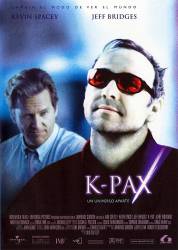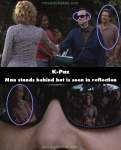Factual error: The lab technician tells Dr. Powell that Prot is sensitive to ultraviolet light, and says "he can detect light up to 300 to 400 angstroms." Normal human vision is considered to be about 390 to 700 nanometers, which is 3900 to 7000 angstroms. The highest light frequency that an animal is known to be able to see is about 280 nanometers, or 2800 angstroms, so he is saying Prot can see a frequency about 10 times higher than any known animal. 300 angstroms isn't just ultraviolet, it is bordering on X-ray. Prot wouldn't just be unusual, he would be a medical marvel demanding worldwide research for his visual range alone. (00:23:00)
Factual error: At the end of the movie, the son arrives from Dartmouth. But he does so in Grand Central Station. To come from New Hampshire he would have to arrive at Penn Station. (01:53:40)







Suggested correction: There no actual mistake here. Just some additional information surrounding the statement made in the film.
Phixius ★
1) While Prot is painted as having many abilities so unusual as begging people to accept him as not human, the ability to see that light frequency would cause the medical professional to jump out of their skin and start calling everyone else in the medical field, not just go "wow, that's weird." 2) Seeing those frequencies is essentially impossible to occur for a couple reasons, mainly that it would take multiple simultaneous genetic mutations (the lens would have to mutate to pass and focus that frequency where currently it completely blocks it, the fluid inside the eye [aqueous humor] would also have to mutate since it is also opaque to those frequencies, and the retinal receptors would have to mutate to be sensitive to those frequencies) and no such mutations are known to have ever occurred in any animal, plus the ability for a mutation to be sensitive to extreme ultraviolet (again, those frequencies are almost X-ray) is probably not possible due to the physics involved in how receptors work, meaning for it to happen multiple mutations in the receptors alone would be needed. 3) This isn't a superhero movie where a person seeing X-ray is just accepted; it is a movie attempting to portray a person as bizarre but within the realm of possible, which this isn't. Personally, I think the writers meant to say he was sensitive to 300-400 nanometers and goofed and said angstroms (some people with artificial lens replacements have been know to see up to about 380 nanometers). The lab tech on the other hand would know better and wouldn't make such a mistake, so this is a movie mistake, not a character mistake.
jimba